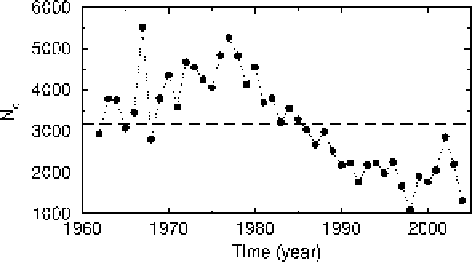Geoscience Reference
In-Depth Information
Fig. 7.7
Annual total
number of dust days recorded
at 175 meteorological stations
of China for 1961-2003. The
dashed line
represents the
long-term mean (From Shao
and Dong
2006
)
TOMS dataset, Riemer et al. (
2006
) demonstrate that the position of the Azores High
is the most important single factor. Doherty et al. (
2008
) combine TOMS/Nimbus 7
(1979-1992) and TOMS/Earth Probe (1998-2000) to analyse summer interannual
variability of North African dust over the Caribbean and conclude that both the
quantity of dust and the length of the dust season were increased during the 1980s
and then plateaued into the 1990s.
Both long-term satellite dust datasets over the Atlantic and ground-based dust
concentrations from Barbados strongly suggest that years of increased dustiness
are associated with reduced rainfall conditions in the Sahel in the previous year
(Prospero and Lamb
2003
; Moulin and Chiapello
2004
; Chiapello et al.
2005
).
Furthermore, the year-to-year evolution of summer surface dust concentrations at
Barbados and satellite-derived DOD over the tropical North Atlantic and the Sahel
show similar variability during the period 1979-2000 and correlate significantly
with drought conditions in the Sahel (Fig.
7.8
).
From these observational studies, it remains difficult to demonstrate direct causal
relationships between atmospheric indices (NAO, rainfall conditions in the Sahel)
and multiannual evolution of dust transport. Furthermore the mechanisms by which
those influences play out are not yet fully understood. Evan and Mukhopadhyay
(
2010
) employed historical satellite aerosol retrievals from AVHRR over the period
1982-2008 to estimate DOD over the tropical North Atlantic. Combining this
satellite dataset with an in situ proxy of atmospheric dust from the Cape Verde
Islands, they reconstruct the annual evolution of DOD over the period 1955-2008.
Their analysis suggests that during the 1950s and 2000s, DOD over the tropical
North Atlantic was at a minimum and peaked during the early 1980s. Thus, a
decreasing trend in Atlantic dustiness is observed over the period 1984-2008,
in agreement with other independent satellite datasets, especially TOMS AOD
during 1980-2006 (Foltz and McPhaden
2008
). The most likely explanation of this
negative trend is a significant increase of rainfall over the Sahel since the mid-1980s.
A recent analysis from Cowie et al. (
2013
) suggests a reduction in dust emission
over the Sahel, associated with reduced peak winds caused by the “greening” in the
Sahel.

Search WWH ::

Custom Search